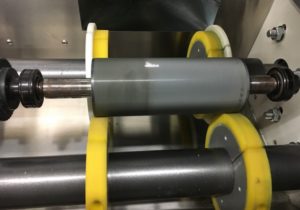Today's Anilox Roll Cleaning
Currently, and for the past several years, we have used four primary means of cleaning anilox rolls. We have hand cleaned using stainless steel brushes and primarily caustic chemicals, ultrasonic, media blasting which limits certain line counts on anilox rolls based on the particulate size of the media. Most recently we have seen high-pressure solution wash systems which also use detergents, chemicals and water. The one thing that each of these methods have in common is that each of them break down ink pigment from the surface of the roll and also the cells of the anilox. But is this really good enough?
The Challenges
Solvent-based inks are made up of primarily of three components. The solvent acts like carrier to get the pigment from the bucket to the substrate, the pigment gives the ink color, and the resin offers performance characteristics such as waxes, the ability to stand up to light and not fade, and scuff resistant properties. Water-based inks are formulated using four primary components, Water acts as the carrier, pigment is the colorant, the amines make the resin soluble, and resins offer of the performance characteristics as mentioned before. Which takes us back to the question we asked before; each of these methods break down the ink pigment from the surface in the cells of the roll but aren't the resins leaving things behind in the anilox cells? The answer is “yes”. That's why even after an anilox roll is clean you often notice the finish being different. For example the roll may have gone from a matte finish to more of a glossy finish because of the remaining waxes within the resin are left behind, as seen in the image below.
The Future of Anilox Roll Cleaning

Simply put laser cleaning an anilox uses light to enter the cells and vaporize all the remaining components of the ink including the resins. There is no LPI beyond the capability of the laser cleaning method, because you cannot escape the light. All of the used anilox rolls in your current inventory have some degree of remaining resins left behind which takes away the ability to carry the full volume (bcm) potential. You could then argue when looking at an ROI of one of these systems are you merely cleaning better, or are you refurbishing your existing inventory to some degree. So when it comes to new technology, there are certain products that seem to change the direction then how we do things; they just become the norm. So why is this? I have to think it's based on four major characteristics. There is ease-of-use, effectiveness or increase of productivity, the sustainability or environmental impact, and safety. But even if a new technology meets all of these criteria, sometimes the pain associated with change to a new solution seems to offset living without the cure. In the case of laser anilox cleaning technology, this certainly is not a hurdle.
Productivity
This new technology is basically plug-and-play. There are no air lines, no water lines, no external exhaust is required, the devices utilize standard power 100/220 V single phase, and the units can be installed within an hour. An operator can literally be trained in only 1 to 2 hours. The manufacturers of the systems use low wattage lasers, for example 20 W. Even at this low level of power, the laser beam is strong enough to vaporize any ink, varnish, coating, or adhesive without touching the ceramic or chrome coating of your anilox rolls. The low-powered lasers offer a deep cleaning into cells like no other technology currently offers. What it comes down to, is that there is no escaping the light. Using 180,000 micro beams or pulses per second, this allows all components of the ink or coating to be vaporized as the light reaches all the way down inside each cell of even the highest line count roll.
Environmental Impact
The sustainability or impact on environment that these lasers have is impressive as well. This anilox cleaning technology does not require any chemicals, media i.e. sodium bicarbonate or polymer beads, water, detergents, or waste disposal of any kind. Equally as impressive, the systems use only 4 kW of power per hour. This low energy consumption is actually less than a standard household dishwasher.
Ease of use
Now let's address the ease-of-use, or automation features of these groundbreaking devices. The touch screen is very basic, easy to understand, and extremely easy to use. The controls are about as basic as one could ever hope for. As we mentioned before, personnel can literally be trained to be an effective operator in just a couple of hours. The laser automatically focuses allowing anilox rolls of various diameters and widths to be cleaned in the same pass without any operator intervention whatsoever. If desired, the roll parameters can then be saved for easy recall, which minimizes any set up time in the future.
Safety
Last, but certainly not least, is the safety features of laser cleaning anilox technology. Eliminating caustic chemicals and waste is definitely at the forefront. Every year individuals suffer from eye injuries and skin irritations/burns from caustic chemicals used in the printing industry. Minimizing the use of these chemicals is certainly a step in the right direction. Lasers used in these cleaning systems are considered to be Class 4, however they are completely contained with interlocks which result in the unit being rated as a Class one device by the FDA. The definition of Class 1 is equipment inherently safe with no possible ability of eye damage.
If you want to learn more about this subject, please feel free to reach out to us by calling 1-800-445-4017, or by e-mail at: [email protected].
All Printing Resources has formed our Technical Solutions Group (TSG) to encompass our full range of expertise in all critical areas of the flexo process. This team is made up of industry professionals dedicated to being up-to-date on new technologies along with best practices. They are armed with the latest in diagnostic tools, and are experienced in problem-solving that can achieve sustainable results. The TSG have walked in your shoes, and have felt your pain.


dear sir,
we are a supplier who focus on offset printing machinery and packaging equipments from overseas market, from China,Japan and European countries.
one of my customers is looking for a anilox ceramic roller cleaning system(laser type) and we kindly ask you to quote this kind of advanced system together with the related informations like video showing real operation, electronic catalogue, technical features(advantages against your competitors) and others if available like Presentation Data.
but if you already had your agent in korea, we sincerely ask you not to send this message to your parnter in korea.
hopely your favorable return to above and best regards,